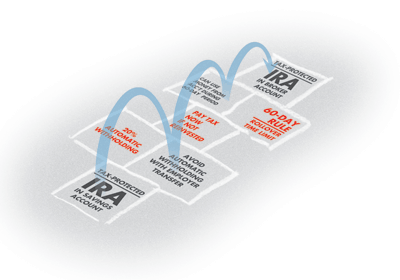Here’s how to take your IRA offshore in 6 steps
In this article I’ll list the steps necessary to take your US retirement account offshore. Whether you’re looking for asset protection, privacy, or investment diversification, here’s how to take your IRA offshore in 6 steps.
Step 1: Determine if your IRA is eligible to go offshore
Before you can move your cash, you must determine which of your retirement accounts are eligible to go offshore. Only accounts that are vested can be moved out of the United States.
A vested account is one that’s under your control. In most cases, an account vests when you leave your employer and take the IRA with you. So, a vested account is typically a retirement account from a previous employer.
It’s possible that a portion of your account with a current employer has vested. If you’ve been working at the same company for 10+ years, you might be able to move a portion of the account offshore. You should speak with HR to see if any of your IRA has vested.
You can also take certain defined benefit plans offshore. If the plan can be converted into an IRA, and in doing so becomes vested, you can move that plan offshore. Eligibility will depend on your defined benefit plan documents. You’ll need to check with your administrator.
Step 2: Move your IRA to a custodian that allows for offshore transfers
Once you know which accounts are eligible to go offshore, you’ll most likely need to move them to a different custodian. Most US firms make money selling you investments. They earn a commission managing your IRA account and don’t want you to move it out from under their control.
There are a few custodians that allow for offshore IRA LLCs. They charge a fixed annual fee of $400 to $600 rather than making money selling investments.
Note that this move must be done as a transfer and not a rollover. If you have multiple accounts, recent changes to the IRS rules make the rollover a problem. However, you can make an unlimited number of transfer of your retirement account (moving it from one custodian to another). Remember that a transfer is not a rollover.
We’ll be happy to introduce you to a custodian that supports offshore accounts.
Step 3: Setup an offshore IRA LLC owned by the IRA
Once you have an account number at your new custodian you can form an offshore IRA LLC. The owner of this account will be your IRA… not you personally and not the custodian.
For example, if your custodian is Midland IRA, the owner of the IRA LLC might be as follows: “Midland IRA, Inc. FBO John Smith #55-5555555” with the number representing your account at Midland. FBO = for the benefit of.
The offshore LLC must be formed in a zero tax jurisdiction, one that allows for single member limited liability companies. The single member of your IRA LLC is your IRA account.
We also focus on countries with strong asset protection laws. For this reason, I like the Cook Islands, Nevis and Belize. The final selection will depend on your banking needs and other factors.
If you’re very concerned about asset protection, you might read the following on using the Cook Islands for maximum protection: Protect Your IRA by Converting it into an Offshore Trust
Step 4: Draft a custom operating agreement establishing you as the manager of the offshore IRA LLC
Now we need to establish you (the beneficial owner of the IRA account) as the manager of the offshore IRA LLC. This is done by drafting a custom operating agreement which lists in great detail your rights and responsibilities.
The bottom line is that you must manage the money in the IRA LLC just as a professional investment advisor would. You should make decisions based on what will maximize returns to the IRA… and those decisions should not benefit you personally.
For example, you can’t borrow from the IRA LLC, can’t use it to buy a home to live in it (even if you pay fair market rent), and can’t use the funds to pay personal expenses
Likewise, you can’t guarantee any of the investments of the IRA. This means you can’t guarantee a loan made to your IRA LLC. All loans taken out by the LLC must be non-recourse secured only by IRA money without a personal guarantee from the beneficial owner.
Step 5: Open an offshore bank account for your IRA LLC
Your IRA is sitting with a custodian that allows for offshore investments, your IRA LLC is incorporated in a secure offshore jurisdiction, and you have a detailed operating agreement giving you control of that LLC. Now it’s time to open an offshore bank account.
The bank selected will depend on the size of the account. If you plan to invest in real estate, and will thus maintain a minimum balance in your offshore account, I recommend Caye Bank in Belize. This bank has high fees but low minimum balances. For more, see: http://www.cayebank.bz/
For accounts of $20,000 and up I recommend Capital Security bank in the Cook Islands (https://www.capitalsecuritybank.com).
- Because CSB does not have branches in the U.S., they have a good handle on FATCA, focus on U.S. clients, and offer a wide range of investment options, I often suggest clients plant their first flag offshore with these banks and then open brokerage accounts or diversify from there.
- Another benefit of Cook Islands is that you do not need to travel there to open the account. All of the recommendations below require you visit the bank in person.
- Finally, CSB is unique in that they don’t lend against client funds. See CSB Low Risk Profile.
In Panama, I recommend Banistmo (https://www.banistmo.com/en), Uni Bank (https://www.unibank.com.pa/en/index.html), and Multibank (https://www.multibank.com.pa/en/default.html). I also suggest Banco General (which is our bank), Santander, Banesco, if you have a local office.
For private vault storage, I recommend Best Safety Boxes in Panama. See http://bestsafetyboxes.com/
For managed accounts over $2m, I recommend Andbanc in Androa or their branch in Panama (http://www.andbanc.com/).
If you prefer a financial advisor and bank in Europe, I recommend Swiss Partners in Geneva. Their website is http://swisspartners-advisors.com. The minimum account size is about $2.5 million.
Step 6: Transfer your IRA cash from the custodian to your offshore bank account
Once you’re account is opened, the custodian will send a wire from their bank to yours. This will move some or all of your cash out of the United States and into an international account that’s under your control.
- You can chose to move all or a portion of your IRA offshore. You can leave some cash with the custodian if you want to make US investments or are new to international banking and want take it slow.
As the manager of the LLC, and the only signatory to the offshore bank account, all investment decisions rest with you. You’re the only person who can send a wire or write a check… which is why we call this an Offshore Checkbook IRA LLC.
This also means that it’s your responsibility to follow the various rules of IRA management. Here are a few articles you might find useful:
- IRA Gold Rules
- What is UBIT in an IRA?
- How to invest your IRA into offshore hedge funds and active businesses
- Can I buy foreign real estate with my IRA?
- How to get Residency in Panama Using Your IRA
If you have a Defined Benefit Plan that you might want to convert to an IRA, see: Maximum Asset Protection for a Defined Benefit Plan
You will also find that there are many tax benefits for sophisticated IRA investors which are only available offshore. For example, the ability to use a UBIT blocker to eliminate US tax in your IRA from leveraged investments. Also the ability to own a portion of an active business, which is operated outside of the United States, whereby the income from the business flows into your IRA tax free.
Of course the main reasons clients take their retirement accounts offshore is to diversify out of the United States, invest in higher returning opportunities, and protect their assets from civil creditors and uncertain times. These are the core principals of the offshore IRA model and goals we can assist you to achieve.
I hope this article on how to take your IRA offshore in 6 steps has been helpful. For more information, please contact us at info@premieroffshore.com or call (619) 483-1708. We’ll be happy to assist to structure your affairs abroad.












Leave a Reply
Want to join the discussion?Feel free to contribute!